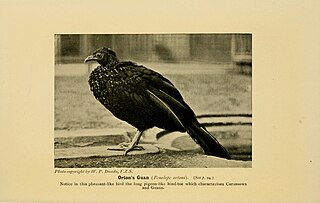
The grey-headed chachalaca is a member of an ancient group of birds of the family Cracidae, which includes chachalacas, guans, and curassows. It is found from Honduras to Colombia.

The black-fronted piping guan or jacutinga in Brazilian Portuguese is a bird in the chachalaca, guan, and curassow family Cracidae. It is found in Argentina, Brazil, and Paraguay.

The Baudó guan is a species of bird from the family Cracidae. It is restricted to humid forests in the west Andean foothills of western Colombia and north-western Ecuador. It is highly sensitive to hunting and habitat destruction, with large sections of the main distribution in the Chocó having already disappeared. Consequently, it is considered to be endangered by BirdLife International and IUCN.

The white-winged guan is a bird in the chachalaca, guan and curassow family Cracidae. It is endemic to northwestern Peru.

The white-tailed goldenthroat is a species of hummingbird in the subfamily Polytminae, the mangoes. It is found in Argentina, Bolivia, Brazil, Colombia, French Guiana, Guyana, Paraguay, Peru, Suriname, Trinidad and Tobago, and Venezuela.

The nocturnal curassow is a species of bird in the family Cracidae, the chachalacas, guans, and curassows. It is found in Brazil, Colombia, Ecuador, Peru, and Venezuela.

The speckled chachalaca is a species of bird in the family Cracidae, the chachalacas, guans, and curassows. It is found in Bolivia, Brazil, Colombia, Ecuador, and Peru.

The buff-browed chachalaca is a species of bird in the family Cracidae, the chachalacas, guans, and curassows. It is endemic to Brazil.

The band-tailed guan is a species of bird in the family Cracidae, the chachalacas, guans, and curassows. It is found in Colombia and Venezuela.

The red-faced guan is a species of bird in the family Cracidae, the chachalacas, guans, and curassows. It is found in Argentina and Bolivia.

The Marail guan or Cayenne guan is a species of bird in the family Cracidae, the chachalacas, guans, and curassows. It is found in Brazil, French Guiana, Guyana, Suriname, and Venezuela.

The rusty-margined guan is a species of bird in the family Cracidae, which includes the chachalacas, guans, and curassows. It is found in Argentina, Bolivia, Brazil, and Paraguay.

The red-throated piping guan is a species of bird in the chachalaca, guan, and curassow family Cracidae. It is found in Bolivia and Brazil.

The white-browed hawk is a species of bird of prey in subfamily Accipitrinae, the "true" hawks, of family Accipitridae. It is found Bolivia, Brazil, and Peru.

The tawny-browed owl is a species of owl in the family Strigidae. It is found in Argentina, Brazil, and Paraguay.

The pale-browed treehunter is a species of bird in the Furnariinae subfamily of the ovenbird family Furnariidae. It is endemic to Brazil.

The blue-throated piping guan is a species of bird in subfamily Penelopina of family Cracidae, the guans, chachalacas, and curassows. It is found in Bolivia, Brazil, Colombia, Ecuador, the Guianas, Peru, and Venezuela.

The East Brazilian chachalaca is a species of bird in the family Cracidae, the chachalacas, guans, and curassows. It is endemic to eastern Brazil.

The Yungas guan is a species of bird in the family Cracidae, the chachalacas, guans, and curassows. It is found in the Andean foothills of Argentina and Bolivia.

The white-throated piping guan is a near threatened species of bird in subfamily Penelopinae of family Cracidae, the guans, chachalacas, and curassows. It is found in Bolivia, Brazil, Paraguay, and Peru.























